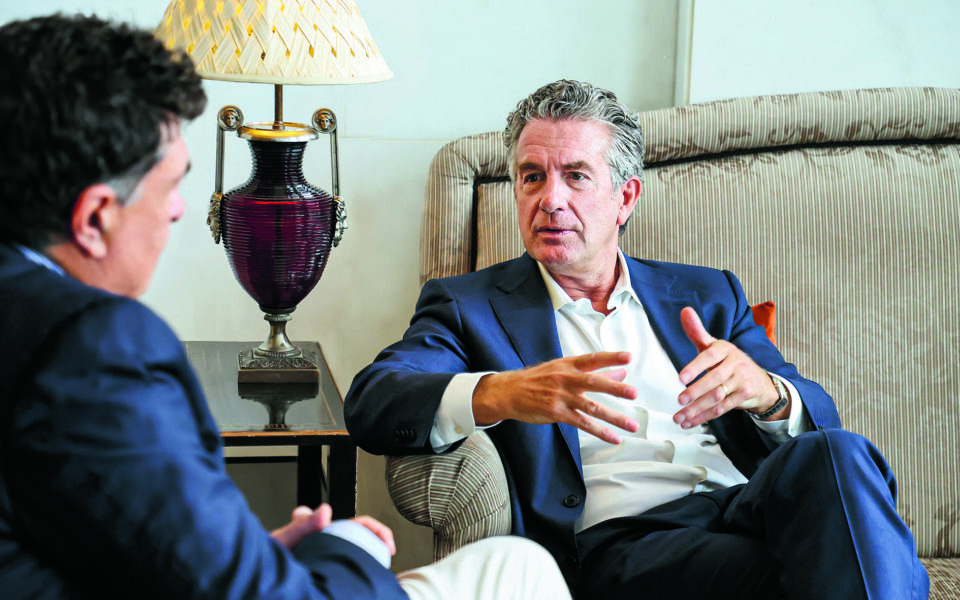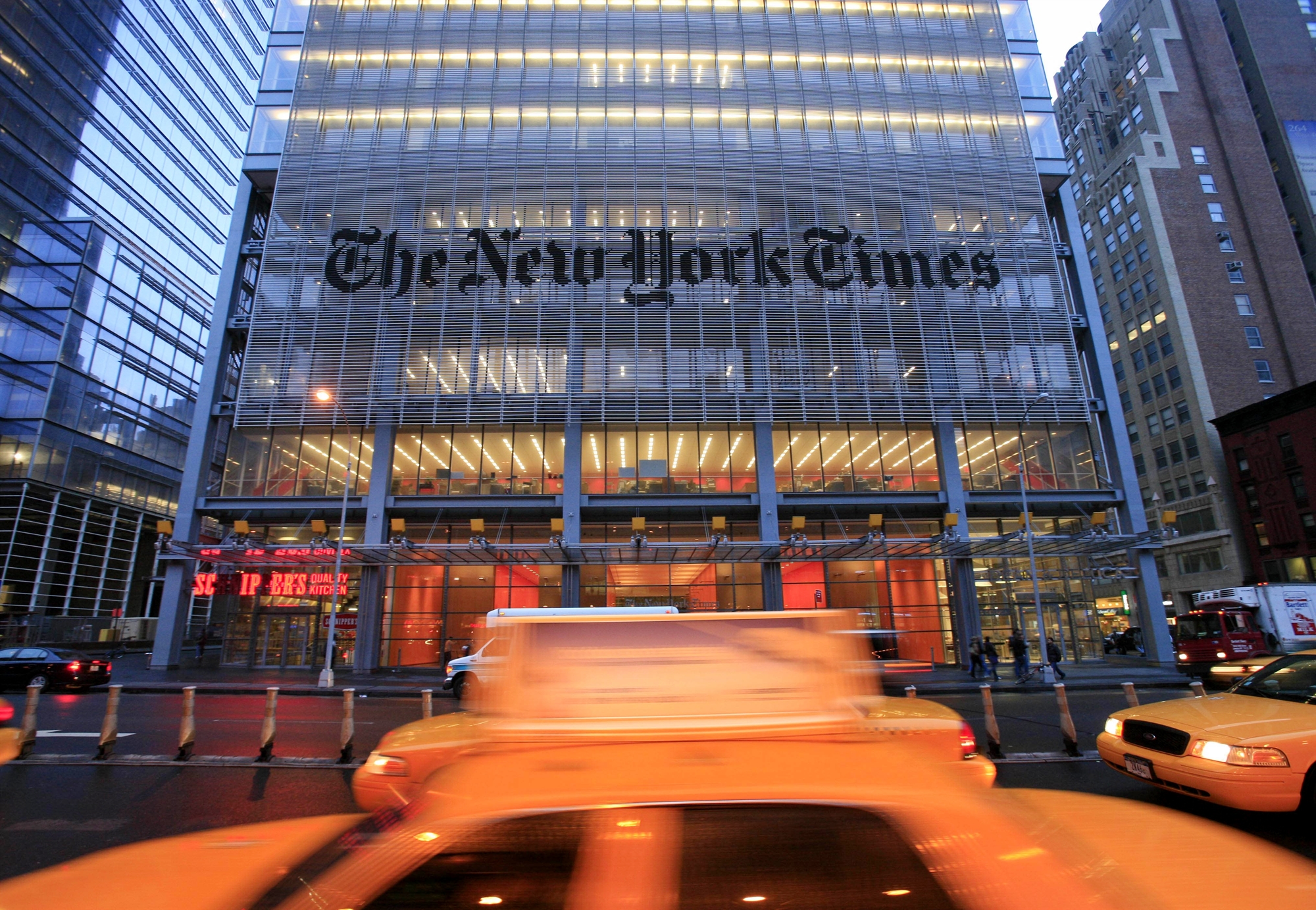The new constellation of journalism
The president, international of The New York Times Company, discusses how newspapers can integrate new technologies and stay profitable

The prophecies about the demise of newspapers have become more outdated than the newspapers themselves, as they are gradually finding ways to survive in the chaotic digital landscape. An illustrative case of this evolution is The New York Times, with which Kathimerini has been in partnership for a quarter of a century.
A media cosmogony has unfolded since the inception of this collaboration. We endeavored to chart this transformation with Stephen Dunbar-Johnson, president, international at The New York Times Company, during his visit to Athens for the Athens Democracy Forum.
It’s been 25 years since we started this project. What has changed in journalism over these 25 years?
When I was flying over coming into Athens, I was thinking about these 25 years. We started this relationship the same year that Google was established. I think it was six years before Facebook was established, nine years before the first iPhone, and 12 years before the first iPad. So to answer your question, we’ve seen probably the most tumultuous period for the media industry ever. It’s disrupted everything. It has undermined the business models that we all relied on to furnish our journalism. But it’s also given us access to more readers than ever before. So the fact that we’ve endured – we still have a print product – our relationship, our partnership has endured through all that, is testimony to, I’m going to say pompously, high-quality journalism and to the commitments of both the Alafouzos family and the New York Times family to high-quality journalism. But it’s a period of the most profound change where we’ve had to think about how we make journalism work across all of the platforms in which people are now consuming that journalism.
I think from our perspective, in a time of real turbulence, there are three lighthouses by which you navigate. And the biggest and most significant lighthouse is high-quality journalism, investing in journalism. Because without that, you don’t have a product. The temptation when the business models are under threat is to cut things and, unfortunately, it has happened in many places. But we believe that you have to invest in the journalism.
Secondly is an unambiguous embrace of technology. At the beginning of this period, a lot of us were kind of fighting technology and trying to avoid it. But you have to embrace it and understand its meaning and the opportunity it provides you.
And the third thing, which is probably in many respects the most difficult for the legacy news publications, was how to understand the customer because it was very much a one-way process. You produce a newspaper, you put it out there and that’s it. You don’t get much feedback from the customer. Now, with data analytics, you can understand everything about it and how to use that to good effect. So those things have all changed dramatically and we’ve had to learn with that. And then how you change the culture around that is a challenge that we, at The New York Times anyway – and I’m sure it has been the same at Kathimerini – tried to grapple with.
Has the newsroom and the way news is gathered changed the news?
Our newsroom has changed quite significantly in that it’s younger, more diverse, and more technically proficient. At a panel discussion we had in New York not so long ago, we had three of our foreign correspondents on stage and they were all under the age of 40, all really superb journalists, and I asked the question, do any of you read your content in print? None of them did! They were all using their phones, and that’s important because we then understand the audience and how most of it is getting their content. The international paper now is doing really quite well and there is a real appetite still for a print product. We’ve found that the serendipitous experience of print product still has legs. So journalism isn’t binary. The platforms are not binary. The print has a role. The mobile phone has a role. All of the surfaces have. Audio has a role, visual has a role. And we need to think of it in all of its complexity. And that’s how it’s changed. It’s got younger, it’s got more diverse, more technical. We have graphics teams now that play a really important part of what we do, because if you can illustrate the text – let’s say you’re doing a story on climate and the Gulf Stream and how the Gulf Stream is maybe changed by changes in temperature and ice collapse – if you can illustrate the text with graphics that are showing you different scenarios, that’s compelling and it helps people. So we’re trying to use all of the tools that you can use to do impactful, high-quality journalism. That’s how it’s changed, it’s continuing to evolve.
The stereotype about The New York Times and Kathimerini was that we’re sort of the gray old ladies of journalism. In this digital world, obviously, we have to deal with this. How has The Times dealt with it? How are you reaching out to different audiences?
I think we still have hold a lot of store in print because print is generating, frankly, a lot of revenue for us. But how we think about print is really downstream of digital. By that I mean, all of our journalism goes into a big intellectual bucket every day. And from that, in that bucket, we think about it in a digital sense. And then how is that going to play across all of the different platforms. Audio is an example of how it’s changing. Our podcast – The Daily – now is global and reaches millions of people every day. It’s hit a billion downloads. That is giving access to The New York Times and our journalism in ways that we just wouldn’t have imagined even five or six years ago. Or something like Modern Love, a feature in The New York Times which has been going on for a long, long time, that’s been converted into TV now quite successfully. Op-docs is something we’re doing. We’ve even pulled an Oscar for one of our op-docs.
If you do good journalism across the spectrum, it can work across every platform. And that’s what we’ve discovered. That’s the liberty, the freedom that technology is giving us. The way people are consuming technology is actually really exciting in ways of getting our journalism into the eyes, ears, and heads of people all over the world in compelling ways. And none of it is binary. We have to work with all of these things. The luxury of sitting back on a weekend with a print product and having that moment with your cup of coffee and that lean-back experience of print is fantastic. The lean-forward experience of what you’re getting on your phone, the urgency, the immediacy of it, the time that you can spend when you’re in the gym listening to good journalism on your phone, on your podcast, all of these services matter. And frankly, they’re also ways that we can monetize.
‘I think we still have hold a lot of store in print because print is generating, frankly, a lot of revenue for us. But how we think about print is really downstream of digital’
There are things like Wirecutter or NYT Cooking that have really expanded the scope. Who thought of these things and how successful are they financially-wise?
They kind of emerge organically. I’ll just give you an example with Cooking. The New York Times has had a tradition in doing recipes for years. If you look in the archives going back 100 years, you’ll see recipes in The New York Times. It’s part of the DNA. So as we started thinking about things in a digital way, we started with what we already have. And some bright spark said, I think we could turn cooking into a business, we could do an app on cooking. Now, frankly, there were quite a lot of naysayers saying that’s never going to work, it’s too competitive, you can get recipes everywhere, but this person was allowed the freedom to go and do that. And one of the things that we discovered very quickly with digital is that you can fail quickly and cheaply. So it’s not much of a risk to ask people to go and do some stuff. They’ve got a good idea or they think they’ve got a good idea. You can be cynical like I was with this product, but let them go. And then what we saw is that they did a beta product, it worked quite well, it was all founded from our content, we actually made it free, grew to over a million people visiting it, and then we said, OK, it’s not making any money, but this now needs to. How are we going to make it? We started asking people to pay for it and it worked very well. And now we have well over a million subscribers for that product. And it makes a significant amount of money for The New York Times. Same with games. The crosswords were already a fundamental part of the DNA of the New York Times, so it was building off of that, putting it in a digital format and giving more people access to it. And so actually it was taking the things that were already part of our values and our DNA. Wirecutter was an acquisition of this company that was doing tests and reviews journalism. In other words, they were going out scrutinizing different products very rigorously and coming to a conclusion about what was the best product. We thought that was interesting, it was based on the quality and the rigor of their journalism, which we think reflected our values, which is why we bought that product. And I think it’s a really interesting acquisition. A lot of people are coming to us through those windows. Meredith Kopit Levien, our CEO, likes to talk about the “Constellation” and The New York Times sits in the middle of the “Constellation,” and then around it you have all of these different products that are part of the ecosystem, and you can come into them and then go explore the other parts. That’s working quite well for us.
There’s been a bit of criticism that, perhaps, during the Trump era, The Times lost some of its objectivity, perhaps under the influence of social media as well. What do you think of it?
I think this is a challenge in the digital age where, in print, there was a very clear piece that said on it “opinion” and the old-fashioned “op-ed” (opposite the editorial pages) and you knew that’s what it was. The challenge in the digital world is that often this opinion gets conflated with news. So, there’s a strong opinion piece, people will say, well, that’s the stance of the news. And it’s a challenge for us because The New York Times and American publications generally have a very clear line between opinion and news. Within our own heads, there is this clear definition, but for most readers, the two things get conflated. So we work quite hard to try and put clear signposts. But fundamentally, despite what everybody says, I think The New York Times just did reporting during the Trump era. The Trump era is so extraordinary. We were just always trying to get to the truth and do the reporting. And some people didn’t like that. The “fake news media” and the “failing New York Times” is, by the way, extremely, extremely damaging. It’s never been more dangerous to be a journalist I think ever. And now journalists are being killed even in the European Union. Many parts of the world, especially for female journalists, are incredibly dangerous. And that kind of rhetoric was very, very damaging.
So people actually felt threatened? Even in the US?
Yes. Journalists are being threatened by that rhetoric and the divisiveness of it. Mounting death threats journalists are getting on a regular basis in the United States and everywhere around the world. But it’s not just us. It’s never been more dangerous to be a journalist in many parts of the world than today, which is which is very disturbing.
How long do you think print will survive?
Well, there are two answers to that. As long as people want to read print and the economics work. The two are related because if you can show that you still have a discerning audience in print and you therefore can attract the revenue and the advertising and the readers, I think print will be around for quite a long time. We see print publications going out of business all the time. But I think some high-quality print media, that has again, a discerning, loyal audience, will find ways of surviving for some time. I don’t know for how long. It could be 10 years. It could be maybe 100 years. I don’t know.
But is there a future for high-quality journalism even beyond print?
Again, it’s not binary. When people say, “Don’t go into journalism, this is a terrible industry,” I understand that because the background to this is true. There have been more job losses in journalism in the United States than coal miners, since the beginning of this century. It’s true that the regional local media has been hollowed out in America. And that’s happening all over the world. We’re here today at a Democracy Forum, and I don’t believe that there can be a true free democracy without a vibrant, independent media. The two are mutually dependent. So it’s really important. But that’s not a print issue. It’s about how we find ways of finding business models that work, that support journalism and print is a part of that. It’s just one part of it. But I’m agnostic, I don’t really care that much. I care about people reading us or listening to us or watching us on whatever platforms they prefer. My job and the job of my colleagues on the business side is to constantly think about how we sustain our journalism, and how we find ways to make that work, economically, across all of these different platforms. What I can say for our international print business, we’re going to be more profitable this year than we were before the pandemic. We have seen a lot of confidence from our advertisers who are coming to us because they recognize that we, in print, are still being read by a lot of opinion leaders and discerning consumers. And our advertising has been very strong this year. So whether that will be the case in five years, I have no idea. But what I do have an idea about is that we’ll still be making enough money to sustain our journalism. And the fact that our newsroom is now more than double the size it was 10 years ago, I think is a testament to that.
You’ve been coming to Greece for a long time. In your own eyes, how has the country changed?
I was thinking about that on the plane too. I was thinking more in the context of when the Athens Democracy Forum started, 11 years ago. And I remember that really Greece was in a difficult time then. It was during the financial crisis and I’ve seen the hardship that this country has had to go through. And actually, “dare to hope” is a theme here. Now Greece is coming out of that, I think I’m right in saying its growing economy is at twice the rate of the European Union now and some credit ratings are giving investment grade. So that’s a hell of a difference from the atmospherics a few years ago. So from what I’ve seen as an observer, I think it has endured and things look much better now.






